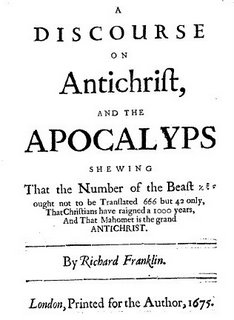
The world seems to have survived 6.6.06, despite those ominous words, ‘Here is wisdom. Let him that hath understanding count the number of the beast: for it is the number of a man; and his number is six hundred three-score and six’: Revelation, 13; 18).
With the abrupt ending of the marking boycott, life is full of the business of moderating numbers, so here’s just a brief post based on Richard Franklin’s argument (from 1675) that the number of the beast had always been misunderstood, and should be construed as 42.
Yes, 42, one of the favourite numbers on the internet, with a whole website devoted to sightings of it at http://www.digitalthoughtsw.com/DTS/42/
That site is, of course, created in homage to Douglas Adams’ Hitchhiker’s Guide to the Galaxy, where the computer Deep Thought calculates ‘the Ultimate Answer to Life, the Universe, and Everything’. After seven and a half million years of computation, '42' is the answer Deep Thought comes up with. To the delight of
Richard Franklin based his argument about a different kind of end-of-the-world on reading the Greek 'chi xi sigma' not as denoting numbers, but as letters that are then to be decoded as numbers (on a simple scheme with alpha as one, and then onwards through the 24 letter alphabet of Greek to omega, so giving him signs in these three cases equivalent to 22, 14, and 6: the product of those numbers being 42). This he can then prove, at least to his own satisfaction, to be the number of Roman emperors prior to Constantine, the first Christian emperor. He goes on to argue that the Antichrist cannot be identified with the Pope, but has (in the 17th century way of these things) to be Mohammed.
What really is interesting here is that sense (again) that the press in the mid 17th century was very much their internet, their way of posting their crazy ideas. Once censorship had lapsed post-1642, and after the burst of urgent controversy in the mid 17thcentury, it looks as though lots of printing presses were chasing work. It clearly didn’t cost very much to publish a pamphlet, so all sorts of ill-advised stuff appeared, 'Printed for the Author'.
3 comments:
There's a discussion of this sort of thing over at Blogging the Renaissance. As an aside, I'm anxious for Arthur Williamson's book, Apocalypse Now, Apocalypse Then to be released some time in the near future. I got hold of some of his recorded lectures on the subject (by the same name), and they're simply fantastic.
This is hilarious. I love it.
As bdh mentions, I posted something on early modern understandings of 666--here's the link to the specific post.
Thank you, Rev. Bob. I really ought to pay more attention to my son's maths homework. A dismal error. Interesting year, 1848: all those revolutions. Must have been the stirrings of the beast. Hieronimo's was indeed a substantial posting. I used to worry about President Reagan's interest in these fantasies (the last days being then within his power to bring on).
Post a Comment